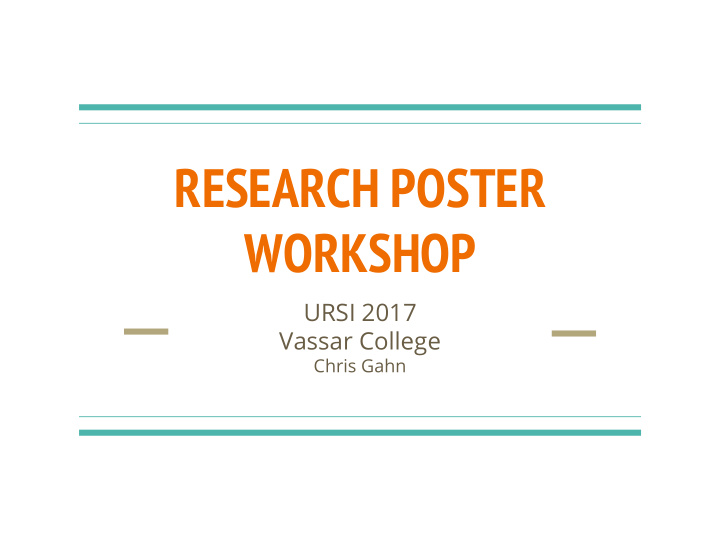



RESEARCH POSTER WORKSHOP URSI 2017 Vassar College Chris Gahn
WHY MAKE A RESEARCH POSTER? ● Make your research accessible ● Invite discussion ● Receive feedback ● Make contacts and network ● Practice presenting research to the public ● Conferences & Poster Contests become résumé material ● Participate in a long tradition of disseminating your work to the research community
GENERAL GUIDELINES & THINGS TO REMEMBER You will be presenting to a wide variety of viewers. ● The average person should walk away with some understanding of ● your project. Translating scientific research for the general public is a valuable ● skill, and will become increasingly important. This is your chance to hone that skill! Always err on the side of succinctness. ● Your poster should be easy to scan from at least 5 feet away. ● Posters are for the audience, not for you and your colleagues. ● Your presence and presentation of your poster can often be as ● important as the poster itself.
MAKE SURE TO INCLUDE The title of your project, often in question form TITLE TITLE ● INTRODUCTION The question you sought to answer and why it matters! ● Your objectives for the project ● METHODS Your methods for the project ● Important figures to help visualize your data and results ● RESULTS An explanation of your results ● Conclusions ● Challenges faced and ideas on how to improve (VERY CONCLUSIONS ● BRIEF!) New questions you have formulated, and the next ● step(s) for your research References - Going to the Source with additional specifics ● REFERENCES from your advisor Acknowledgements ● Funding, contributors, etc. (your academy award thank you’s!) ○
MAKE SURE TO AVOID Do not include an abstract ● TL;DR (wall of text) ● Avoid underlining ● Try not to include tables if a graph will be better. Avoid raw data. ● Find a way to minimize text and emphasize figures 70/30 figures/text. ● Abrasive or hard-to-read color schemes. Often, the printed version of ● colors is different than the on-screen version. Make sure that nothing clashes or is difficult to read by printing your poster on 8.5x11 to get an idea of the printed color (yellow text is a horrible idea!). Don’t overshadow your message with flashy colors or backgrounds. Make ● healthy use of the transparency feature. Do not steal images! If in doubt, check with your advisor! Cite your ● sources!
LAYOUT The recommended dimensions are (36”x45”) in order to fit in ● the poster frames in BLS/Olmstead, but you may elect a different size after discussion with your advisor. Print resolution is 300dpi, if your poster is the correct size in ● inches, your images should look sharp at their respective sizes. Flow each section into the next, but make sure to label the ● different sections clearly. Make it easy for the viewer to follow your steps. Make figures large enough to see from about 5 feet ● A “clean” look is much better than a flashy, colorful poster ● that distracts from your message. Less is often more.
FONT & SIZE Font Use a clean, sans serif font, and use no more than three different fonts. ● Arial usually works well for Titles & Axis Labels. ● Continuous text paragraphs often display well with Century Gothic or Avant ● Garde . Avoid using Times or Times New Roman because they don’t scale well. ● Don’t underline, and use boldface only for titles or headings. ● Size Main text should be around ~34 point ● Sub-Headings around ~42 point ● Title ~120 point ● Graphs ~20-26 point ● Acknowledgements ~22 point ●
LIKE ANYTHING ELSE, PROOF-READ! ● Once you have saved your poster as a PDF, go through each and every line and make sure that it matches what you have in your project file. ● Ask a friend or professor (preferably both) to read through your poster and give you feedback. ● Make sure all of your figures are displaying what you think they are! ● Run through a few mock presentations of your poster with friends or family. This will often result in questions you had not anticipated.
CREATING FIGURES If your software exports figures, try to use the PNG format for best ● compression. When creating figures from scratch, use Google Drawings. ● Screenshots ● Mac: Command+Shift+4 gives crosshairs ○ Windows: Snipping Tool (search for snipping tool) ○ Linux: Usually Shift+Print Screen button ○ Avoid using Microsoft Word ● Photoshop and/or Illustrator work great too, but the learning curve can be ● a little steep. Adobe Creative Suite is installed on all of the SciVis computers.
DEADLINES & REQUIREMENTS FOR URSI Find the official instructions on ursi.vassar.edu/students/posters/ ● Final Poster Submission September 16th 2016 ● PDF File ○ Email/Share to chgahn@vassar.edu ○ Poster Requirements: ● Size: 36” wide x 45” tall, portrait orientation ○ Format: your final poster must be saved as a PDF ○ Creation: The preferred method for creating your poster is to use the PowerPoint URSI ○ Poster Template, however, you can use any appropriate software tool to create your poster (e.g. Illustrator, InDesign, PowerPoint, Keynote, Google Slides), as long as you save your final work as a PDF file. Maximum File Size: 100 MB (if it’s larger, contact Chris Gahn <chgahn@vassar.edu> prior ○ to the submission deadline for help on reducing the file size) File naming convention: URSI_posterNumber_facultyUsername_studentUsername.pdf ○ where Username is the username that is used for the Vassar email address. For example: URSI_B01_joschwarz_beterry.pdf If you do not use this naming convention, your poster will not be printed. ○ If you do not know your posterNumber, contact Susie Painter <supainter@vassar.edu> ○ immediately.
BAD EXAMPLES
TEMPLATE https://tinyurl.com/yb3ph6dk
Recommend
More recommend